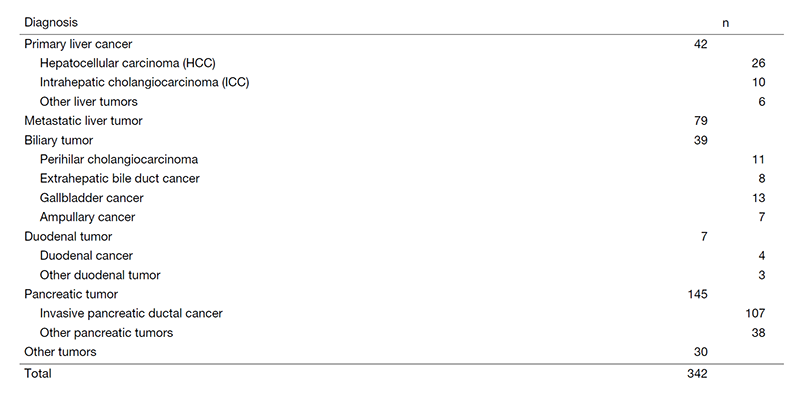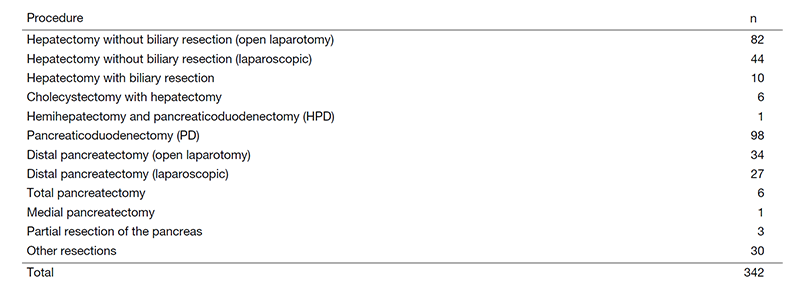Annual Report 2020
Department of Hepatobiliary and Pancreatic Surgery
Minoru Esaki, Daisuke Ban, Satoshi Nara, Takeshi Takamoto, Takahiro Mizui, Daisuke Nagashima, Kazuaki Shimada
Introduction
The Department of Hepatobiliary and Pancreatic (HBP) Surgery manages malignant neoplasms arising from the liver, biliary tract including the gallbladder, and pancreas. We conduct aggressive surgical treatment and multidisciplinary treatment in cooperation with the Department of Diagnostic Radiology, Department of Hepatobiliary and Pancreatic (HBP) Oncology and the Pathology Division.
The Team and What We Do
The Department of HBP Surgery consists of five staff surgeons. We perform more than 300 surgical procedures each year, with one chief resident and three or four residents. Occasionally, trainees from both Japan and overseas join our group.
Operation and perioperative care
One staff surgeon and one resident are in charge of each patient, conduct the operation and provide postoperative care. The chief resident attends all the operations, supervises the residents and manages the care of all patients in the ward.
Conferences
Clinical and educational conferences on the diagnosis and treatment of HBP malignancies are held every morning. At the “Ward Conference”, the clinical conditions of the perioperative patients and the surgical strategies are discussed in detail for the preoperative patients twice a week. At the multidisciplinary team conference, so-called “Cherry Conference,” surgeons, physicians, endoscopists, oncologists, radiologists and medical sonographers discuss the imaging studies of the patients scheduled for HBP surgery. An “HBP Case Conference” is held by HBP surgeons, endoscopists and oncologists to discuss treatment strategies, mainly for new patients. In a pathology conference, so-called “Micro-conference”, instructive postoperative cases are discussed, where surgeons, physicians, radiologists, and pathologists participate.
Surgical strategies for HBP malignancies
Hepatocellular carcinoma (HCC): Surgical resection is usually indicated for patients with solitary or only a few tumors and with favorable hepatic function. Resection is also indicated for large tumors or HCC with macroscopic vasculobiliary tumor thrombosis, provided sufficient hepatic function and remnant liver volume can be expected. Alternative treatments to hepatectomy, such as radiofrequency ablation, microwave ablation and trans-arterial chemoembolization, are always available in cooperation with medical oncologists and radiologists.
Pancreatic cancer: Multidisciplinary treatments with curative resection with neoadjuvant and adjuvant chemotherapy constitute the standard strategy. Thanks to recent advances in systemic chemotherapy with improved response, the opportunities for conversion surgical resection for initially unresectable cancer due to locally advanced disease have been increasing.
Biliary cancer, cholangiocarcinoma and gall bladder cancer: Based on careful imaging evaluations of cancer extension, a wide variety of surgical resections can be applied to biliary cancer. Major resection including pancreatoduodenectomy and extended hemihepatectomy with extrahepatic bile duct resection, with or without vascular reconstruction, is frequently indicated. A safe and curative resection with careful perioperative management is essential.
Laparoscopic surgery: Laparoscopic hepatectomy is considered a first-choice treatment for most liver tumors. Laparoscopic distal pancreatectomy and laparoscopic spleen-preserving distal pancreatectomy are also performed for patients with mainly low-grade malignant pancreatic tumors. Based on our experience with laparoscopic surgery, we are expanding the indication to invasive ductal cancer of the distal pancreas.
The number of diseases and surgical treatments are shown in Table 1 and 2. The long-term outcomes after surgery in our department for pancreatic cancer, HCC, and gallbladder cancer are shown in Table 3.
Table 1. Diagnosis for surgical treatment (between April 2020 and March 2021)

Table 2. Surgical procedures (between April 2020 and March 2021)

Table 3. Postoperative survival rates of patients with a) pancreatic invasive ductal cancer, b) hepatocellular carcinoma and c) gallbladder cancer
a) Pancreatic cancer (intraductal carcinoma) (2005-2014)

b) Hepatocellular carcinoma (2005-2014)

c) Gallbladder cancer (2000-2014)

Research activities
Dr. Shimada et al. are conducting two multi-institutional randomized trials. One is to evaluate the safety of drainage-tube-free hepatectomy (ND-trial), the results of which were published in 2020. The other is to evaluate the efficacy of administrating digestive enzymes to prevent postoperative hepatic steatosis in patients who underwent pancreaticoduodenectomy (ESOP trial), for which patients’ recruitment has been completed and the data are being analyzed.
We are participating in an international collaboration project by EORTC (European Organization for Research and Treatment of Cancer) and JCOG (Japan Clinical Oncology Group). The aim of the project is to evaluate the accuracy of diffusion-weighted magnetic resonance imaging for assessing diminishing colorectal liver metastases by chemotherapy (DREAM study).
Dr. Nara et al. are conducting a randomized phase III study of neoadjuvant chemotherapy with gemcitabine/cisplatin/S-1 (GCS) versus upfront surgery for resectable biliary cancer.
Each staff member attends three to four domestic or international academic meetings per year. Residents and chief residents also have opportunities to make a presentation with the assistance of staff surgeons.
Clinical trials
In addition to the two above-mentioned RCTs (ND-trial and ESOP trial) and the DREAM study, a single institutional clinical trial to evaluate the R0 resection rate following preoperative SIROX therapy for borderline resectable pancreatic cancer was initiated in June 2018. We are also conducting two prospective clinical studies in cooperation with several domestic companies, aiming to develop surgical imaging tools using artificial intelligence that can assist liver resection (VAN-GOCH study, MARC01 study).
Education
Each resident attends one to two major HBP surgeries mainly as a first assistant. Depending on their skill, they also have the opportunity to act as an operator. For each case, they learn how to decide on the indication and the type of procedure based on the preoperative images. In the operating room, the residents learn not only each step of HBP surgery, but also the tips on how to safely proceed with the surgery. The chief resident trains the residents in a two-year program. In the first year, they devote themselves to the management of all inpatients and attend basically every surgery. Depending on the development of their skills, they have the opportunity to act as an operating surgeon for major HBP surgery. In the second year, the chief resident works on research studies and publishes several English papers. Motivated residents also have the opportunity to make presentations in academic meetings and write English papers. Visitors from both domestic and foreign institutions are welcome anytime.
Future prospects
HBP malignancy often requires technically-demanding and invasive surgical procedures; however, the long-term prognosis is not yet satisfactory. Our most important mission is to establish safer and more feasible surgical techniques, including perioperative patient management, and to promote survival outcomes through multidisciplinary approaches. Due to recent advances in chemotherapy, we have achieved curative surgical resection for some of our patients with initially unresectable pancreatic cancer due to local advancement. We will therefore prospectively assess the feasibility of conversion therapy.
Minimal invasive surgical treatments with laparoscopic surgery have been established for selected patients with low-malignant distal pancreatic tumors or primary/metastatic liver cancers that are peripherally located. We started to expand the indication of laparoscopic surgery for patients with more aggressive disease and undergoing repeat surgery.
We will continue to strive to create new skills and treatment strategies. We also expect to perform clinical trials to explore unclarified clinical questions.
List of papers published in 2020
Journal
1. Shibayama T, Makise N, Motoi T, Mori T, Hiraoka N, Yonemori K, Watanabe SI, Esaki M, Morizane C, Okuma T, Kawai A, Ushiku T, Yatabe Y, Yoshida A. Clinicopathologic Characterization of Epithelioid Hemangioendothelioma in a Series of 62 Cases: A Proposal of Risk Stratification and Identification of a Synaptophysin-positive Aggressive Subset. Am J Surg Pathol, 45:616-626, 2021
2. Arita J, Sakamaki K, Saiura A, Konishi M, Sakamoto Y, Hashimoto M, Sano T, Uesaka K, Kokudo N, Yamanaka T, Shimada K. Drain Placement After Uncomplicated Hepatic Resection Increases Severe Postoperative Complication Rate: A Japanese Multi-institutional Randomized Controlled Trial (ND-trial). Ann Surg, 273:224-231, 2021
3. Iwasaki T, Nara S, Nishimura Y, Ueda H, Kishi Y, Esaki M, Shimada K, Hiraoka N. Postoperative acute multiple organ failure after hepatectomy in a Nigerian male with sickle cell trait: a case report. Surg Case Rep, 7:19, 2021
4. Ban D, Nara S, Takamoto T, Mizui T, Yoshino J, Esaki M, Shimada K. Revisiting the role of the hepatic vein in laparoscopic liver resection. Hepatoma Res, 7:2021
5. Nakata K, Higuchi R, Ikenaga N, Sakuma L, Ban D, Nagakawa Y, Ohtsuka T, Asbun HJ, Boggi U, Tang CN, Wolfgang CL, Nishino H, Endo I, Tsuchida A, Nakamura M. Precision anatomy for safe approach to pancreatoduodenectomy for both open and minimally invasive procedure: A systematic review. J Hepatobiliary Pancreat Sci, 2021
6. Ban D, Garbarino GM, Ishikawa Y, Honda G, Jang JY, Kang CM, Maekawa A, Murase Y, Nagakawa Y, Nishino H, Ohtsuka T, Yiengpruksawan A, Endo I, Tsuchida A, Nakamura M. Surgical approaches for minimally invasive distal pancreatectomy: A systematic review. J Hepatobiliary Pancreat Sci, 2021
7. Nishino H, Zimmitti G, Ohtsuka T, Abu Hilal M, Goh BKP, Kooby DA, Nakamura Y, Shrikhande SV, Yoon YS, Ban D, Nagakawa Y, Nakata K, Endo I, Tsuchida A, Nakamura M. Precision vascular anatomy for minimally invasive distal pancreatectomy: A systematic review. J Hepatobiliary Pancreat Sci, 2021
8. Nagakawa Y, Watanabe Y, Kozono S, Boggi U, Palanivelu C, Liu R, Wang SE, He J, Nishino H, Ohtsuka T, Ban D, Nakata K, Endo I, Tsuchida A, Nakamura M. Surgical approaches to the superior mesenteric artery during minimally invasive pancreaticoduodenectomy: A systematic review. J Hepatobiliary Pancreat Sci, 2021
9. Muro S, Sirirat W, Ban D, Nagakawa Y, Akita K. What comprises the plate-like structure between the pancreatic head and the celiac trunk and superior mesenteric artery? A proposal for the term "P-A ligament" based on anatomical findings. Anat Sci Int, 96:370-377, 2021
10. Konishi T, Takamoto T, Hashimoto T, Makuuchi M. Is portal vein embolization safe and effective for patients with impaired liver function? J Surg Oncol, 123:1742-1749, 2021
11. Sekiguchi M, Igarashi A, Sakamoto T, Saito Y, Esaki M, Matsuda T. Cost-effectiveness analysis of colorectal cancer screening using colonoscopy, fecal immunochemical test, and risk score. J Gastroenterol Hepatol, 35:1555-1561, 2020
12. Lin Y, Nakatochi M, Hosono Y, Ito H, Kamatani Y, Inoko A, Sakamoto H, Kinoshita F, Kobayashi Y, Ishii H, Ozaka M, Sasaki T, Matsuyama M, Sasahira N, Morimoto M, Kobayashi S, Fukushima T, Ueno M, Ohkawa S, Egawa N, Kuruma S, Mori M, Nakao H, Adachi Y, Okuda M, Osaki T, Kamiya S, Wang C, Hara K, Shimizu Y, Miyamoto T, Hayashi Y, Ebi H, Kohmoto T, Imoto I, Kasugai Y, Murakami Y, Akiyama M, Ishigaki K, Matsuda K, Hirata M, Shimada K, Okusaka T, Kawaguchi T, Takahashi M, Watanabe Y, Kuriki K, Kadota A, Okada R, Mikami H, Takezaki T, Suzuki S, Yamaji T, Iwasaki M, Sawada N, Goto A, Kinoshita K, Fuse N, Katsuoka F, Shimizu A, Nishizuka SS, Tanno K, Suzuki K, Okada Y, Horikoshi M, Yamauchi T, Kadowaki T, Yu H, Zhong J, Amundadottir LT, Doki Y, Ishii H, Eguchi H, Bogumil D, Haiman CA, Le Marchand L, Mori M, Risch H, Setiawan VW, Tsugane S, Wakai K, Yoshida T, Matsuda F, Kubo M, Kikuchi S, Matsuo K. Genome-wide association meta-analysis identifies GP2 gene risk variants for pancreatic cancer. Nat Commun, 11:3175, 2020
13. Nara S, Esaki M, Ban D, Takamoto T, Shimada K, Ioka T, Okusaka T, Ishii H, Furuse J. Adjuvant and neoadjuvant therapy for biliary tract cancer: a review of clinical trials. Jpn J Clin Oncol, 50:1353-1363, 2020
14. Yamamoto Y, Kondo S, Matsuzaki J, Esaki M, Okusaka T, Shimada K, Murakami Y, Enomoto M, Tamori A, Kato K, Aoki Y, Takizawa S, Sakamoto H, Niida S, Takeshita F, Ochiya T. Highly Sensitive Circulating MicroRNA Panel for Accurate Detection of Hepatocellular Carcinoma in Patients With Liver Disease. Hepatol Commun, 4:284-297, 2020
